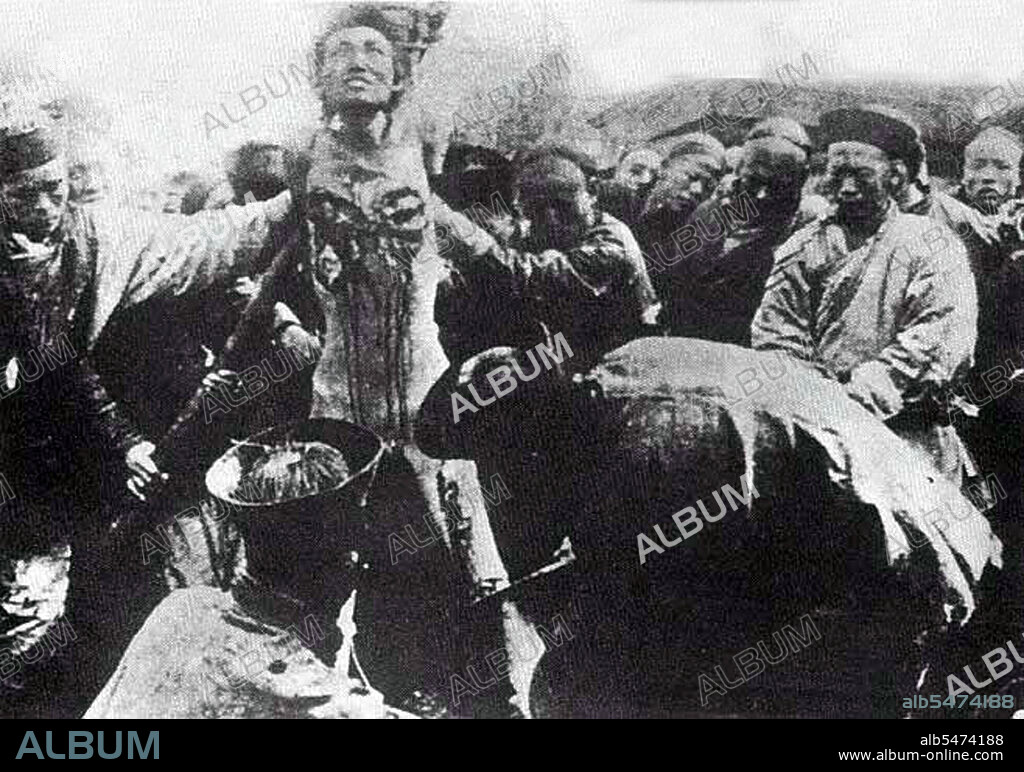alb5474188
An execution by the 'Death of a Thousand Cuts', late Qing period.

|
Zu einem anderen Lightbox hinzufügen |
|
Zu einem anderen Lightbox hinzufügen |



Haben Sie bereits ein Konto? Anmelden
Sie haben kein Konto? Registrieren
Dieses Bild kaufen

Titel:
An execution by the 'Death of a Thousand Cuts', late Qing period.
Untertitel:
Automatische Übersetzung: Langsames Schneiden (Pinyin: Lingchi, auch transkribiert als Ling Chi oder Leng T'che), auch übersetzt als der langsame Prozess, der schleichende Tod oder Tod durch tausend Schnitte, war eine Hinrichtungsform, die in China von etwa 900 n. Chr. bis zu ihrer Abschaffung im Jahr 1905 angewandt wurde. Bei dieser Hinrichtungsform wurde der Verurteilte getötet, indem mit einem Messer über einen längeren Zeitraum hinweg systematisch Teile des Körpers entfernt wurden. Der Begriff Lingchi leitet sich von einer klassischen Beschreibung des langsamen Aufstiegs auf einen Berg ab. Lingchi war für Verbrechen reserviert, die als besonders schwerwiegend angesehen wurden, wie Hochverrat und die Ermordung der eigenen Eltern. Bei diesem Verfahren wurde die hingerichtete Person an einen Holzrahmen gebunden, normalerweise an einem öffentlichen Ort. Das Fleisch wurde dann in mehreren Scheiben aus dem Körper geschnitten, ein Verfahren, das im chinesischen Gesetz nicht näher festgelegt war und daher höchstwahrscheinlich variierte. In späteren Zeiten wurde manchmal Opium verabreicht, entweder als Akt der Gnade oder als Mittel zur Vorbeugung von Ohnmachtsanfällen. Die Bestrafung wirkte auf drei Ebenen: als Form der öffentlichen Demütigung, als langsamer und schleppender Tod und als Strafe nach dem Tod. Letztere bedeutete, dass der Körper des Opfers in Stücke geschnitten wurde und somit nicht mehr „vollständig“ war und nach dem Tod ein spirituelles Leben führen konnte.
Slow slicing' (pinyin: lingchi, alternately transliterated Ling Chi or Leng T'che), also translated as the slow process, the lingering death, or death by a thousand cuts, was a form of execution used in China from roughly 900 CE until its abolition in 1905. In this form of execution, the condemned person was killed by using a knife to methodically remove portions of the body over an extended period of time. The term lingchi derives from a classical description of ascending a mountain slowly. Lingchi was reserved for crimes viewed as especially severe, such as treason and killing one's parents. The process involved tying the person to be executed to a wooden frame, usually in a public place. The flesh was then cut from the body in multiple slices in a process that was not specified in detail in Chinese law and therefore most likely varied. In later times, opium was sometimes administered either as an act of mercy or as a way of preventing fainting. The punishment worked on three levels: as a form of public humiliation, as a slow and lingering death, and as a punishment after death. The latter as to be cut to pieces meant that the body of the victim would not be 'whole' in a spiritual life after death.
Bildnachweis:
Album / Pictures From History/Universal Images Group
Freigaben (Releases):
Model: Nein - Eigentum: Nein
Rechtefragen?
Rechtefragen?
Bildgröße:
5000 x 3511 px | 50.2 MB
Druckgröße:
42.3 x 29.7 cm | 16.7 x 11.7 in (300 dpi)
Schlüsselwörter:
 Pinterest
Pinterest Twitter
Twitter Facebook
Facebook Link kopieren
Link kopieren Email
Email
